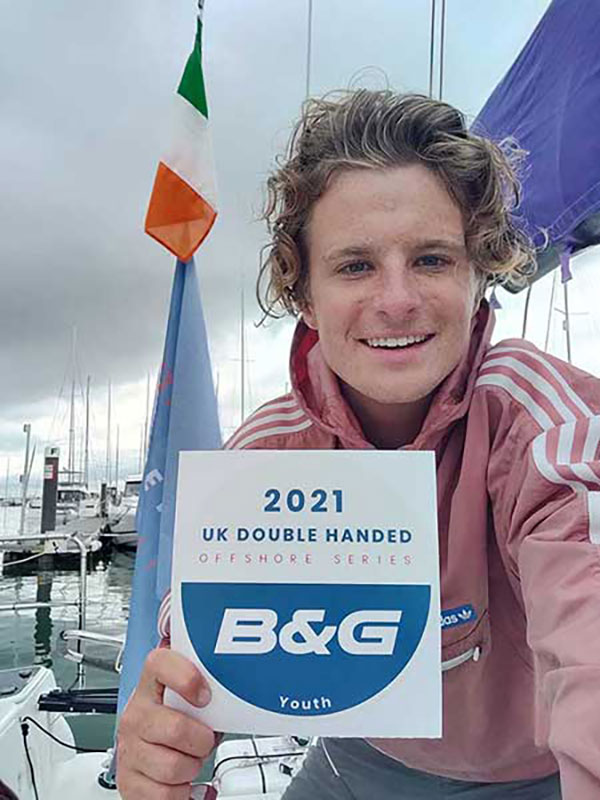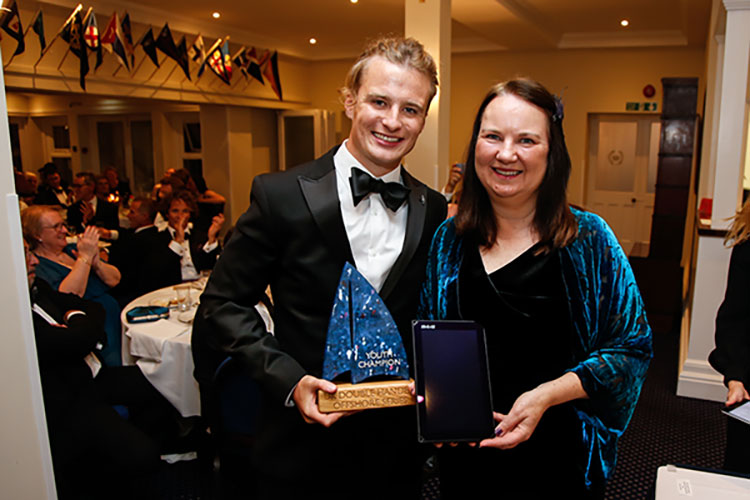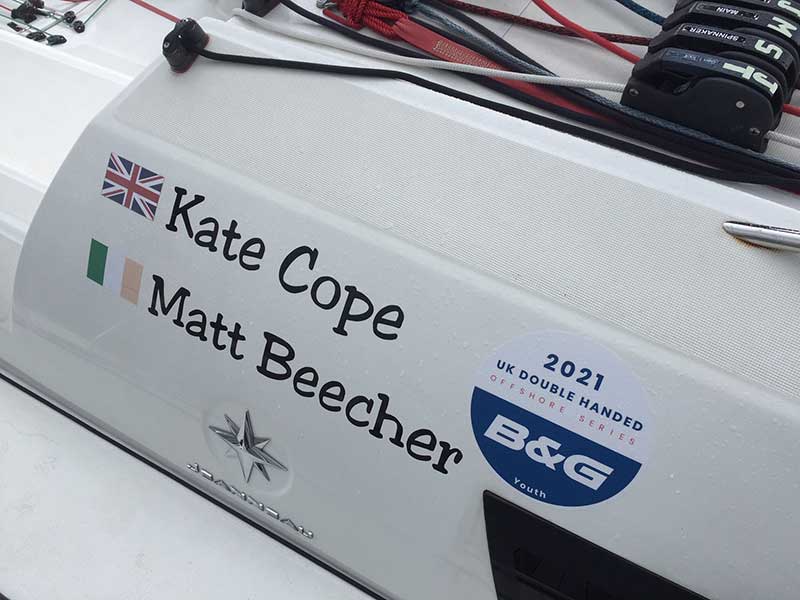Matt Beecher, a young sailor from Ireland, talks us through his first sail in English waters in 2019, the challenging conditions of the FastNet and his ambitions to reach the top of the offshore yacht racing scene.
Matt Beecher, Co-skipper
Where it all began
I started sailing as part of my job back home in Kinsale in Ireland. I was asked to join a yacht racing crew last minute for a Wednesday night summer series race, and I had never been on a yacht before. Skill wise, I was a pretty below par dinghy sailor and involved in, but not naturally talented at, rugby and long distance running. As a person I live on a very short term basis, seeking instant gratification and to constantly step things up a level with little patience. Within a year of learning how to race a "big boat" I was pushing hard to step it up a level, going to national championships in 2 different keelboat classes, racing in some of the biggest regattas in Ireland and getting exceptional feedback from my teammates as I went along. Aged 18 I moved to the UK for University and this was where I got my first taste of rejection in sailing. I did not make it onto the University sailing team, and that really hurt. I really believed that University was going to be my opportunity to refine my skills and learn how the seemingly superior Brits were so dominant in the sailing world, and I wasn't even allowed to train in the same squad as the top guys and girls. Within an hour of being rejected I had emailed all of the racing skippers I could find details for in the area, and I was back on the racing scene within a couple of weeks.
I had my sights set on the Rolex Fastnet Race after reading the book "Left for Dead" by Nick Ward. I spoke about this goal with everyone who would listen and eventually I was invited to come and meet the owner of 'Simples', a high performance, highly experienced and well run racing team. He had already chosen his Fastnet crew but I didn't care, it was my pleasure to just be involved in the preparation for such an amazing race. Every couple of weeks I travelled by bus for 7 and a half hours each way to go sailing on Simples, which ultimately resulted in me not being able to afford nights out back at University. I didn't care, I was just so keen to keep my foot the door with Simples. My dedication was soon rewarded with a spot on the team due to somebody else pulling out, and even though I was the youngest I was quickly accepted and respected as a member of the team. I finished my first Fastnet race aged 20, and within weeks of being back on land I was starting a double handed campaign. 2 years later, I confirmed that I am the fastest youth skipper in the UK and now I am going to step it up a level by becoming the fastest rookie on the Figaro Circuit next year. I am currently seeking a title sponsor for this campaign, and whoever decides to partner with me will be become. crucial part of the fastest growing and most ambitious sailing story of this generation.

Setting sail on English waters
For me, a young Irish sailor, this series was exactly the step I needed to take in the UK. I first sailed in British waters during the 2019 RORC season on a fully crewed boat called Simples, and immediately got bitten by the offshore racing bug. The pinnacle of offshore racing is the short handed discipline, and the double handed class is one which is notoriously difficult to enter. This is due to the most successful double handed pairs being long established and loyal to each other, and the budding campaigns only ever requiring one high performance individual (as opposed to fully crewed teams being able to accept one extra sailor to their team when they see fit).
Thankfully, I networked enough to convince Kate to give me a shot, and she immediately picked up on, and supported, my ambition and drive. We were both aware that this series was going to be the highest performance sailing either of us had done, with the competition including sailors from the Vendee globe, Volvo Ocean race, Figaro Circuit, Olympics plus the already established and successful double handed teams.
To participate in this series was a massive achievement for me, and to then go and become the fastest youth skipper in the series simply confirmed the beliefs I had in myself and our team at the beginning of our campaign. One of the high points of this series for me was the huge engagement I was having from the people who tuned into my instagram stories as I documented the highs and lows of each race in 2021. (@machubeecher on instagram). The series really welcomed the use of social media and, due to this, we, as a group of passionate sailors, quickly gathered many keen followers.
Racing the storm at RORC Fastnet
The beginning of the Rolex Fastnet Race for me was the worst conditions I had ever sailed in. For the first day or so we received a continuous stream of news about who had not successfully made it through the storm, which was quite a bittersweet feeling. It's obviously sad to hear that one third of the fleet had to retire, however these were our competitors. Kate and I were having difficulties of our own with injuries and illness, and in hindsight the news of boats breaking and people not being able to carry on was fuel to the fire for me. It gave me an increased sense of trust in the boat and belief in Kate and I as a double handed partnership. The day after the storm was our first chance to get involved in some technical sailing in moderate to light conditions, an area of our training where we were well versed and quite consistent throughout the UK Double Handed Offshore Series.
Lands' End to the Fastnet Rock and back was an interesting leg, with heavy airs reaching towards the rock, light airs at the rock with a beautiful sunset and heavy airs reaching all the way back to the Isles of Scilly. At Scilly we used our downwind sails for the first time in the race, and within minutes reached the top speed for the boat since she was built: 15.3knots. The sea state was massive, the sun was shining, and Kate and I were on a mission. We attacked and attacked all the way up the English channel, consistently picking off boats and moving from pack to pack; morale was high, we were singing songs and going fast while pushing through the unending suffering. The race ended in sunny Cherbourg with massive tides and moderate breeze which was gradually dropping (a recurring set of conditions at the finish line in this year's series!). Raising the Irish Tricolour in Cherbourg Harbour and crying with joy is a moment that gives me shivers to write about right now.
B&G® On Board Purple Mist
For me, marine electronics are most valuable when they are practical, reliable and do not require much effort to use or understand. The less time you spend cycling through settings or re entering information, the more time you can spend on sail trim, helming, forecasting and recovering. The way we set up our B&G system at the beginning of the campaign was bespoke to our style of sailing as a pair, which helped us know exactly the order of buttons to press on the triton display while helming to easily go from offshore reaching mode all the way to docking mode, or to quickly change all displays to night mode, or to quickly switch one of our 20/20 Mast displays from depth to true wind speed as we got into deep water.
On the Sunfast 3200R2 we used three B&G 20/20s for our mast displays, one B&G Zeus 3S as our plotter in the cockpit, two B&G Triton 2s (one on each helming station), two pilot keypads (one on each helming station which used the tritons as their display) and the B&G WR10 Wireless Remote on a lanyard for the times when you're solo on deck and not sitting by the helm. Down below, we used a screen sharing app on an ipad to access the Zeus display to save us going up on deck to navigate during our off watch time.
At the Southampton Boat show I had a chance to get familiar with the latest B&G Nemesis display, and couldn't believe that it's running android software. The customizability and user friendliness of this new technology really impressed me, and I feel it will really compliment the already bespoke and well tuned electronics on Purple Mist.
A race to the top
The future for me is simple, I want to become one of the greatest adventurers to ever live. I will push hard to reach the top of the offshore yacht racing scene, and once I get there I will have all of the necessary skills and contacts to break records, explore uncharted areas and as always, exceed all expectations that people have for me.
Kate Cope
Stepping on board with Kate, Purple Mist owner, she talks us through the origins of the race series and the gruelling conditions of race day.
UK Double Handed Offshore Series Origins
Henry Bomby, who had the idea for the double handed series, asked me to help him create the series to bring a corinthian perspective. We wanted to bring the double handed community together - both Pro and Corinthian sailors. This allows us to share training and coaching and by racing against each other we help everyone build their skills and improve their results. Matt and I are both relatively new to offshore racing and the series has given us plenty of coaching and feedback opportunities. We have definitely benefited, our results have been getting stronger as the season has progressed.


Racing the storm at RORC Fastnet
The final race of the Series , RORC Fastnet, was brutal. We set off bashing into 30kts of wind blowing against a spring tide creating huge waves in the Solent and at the Needles. The first 12 hrs was all about protecting the boat and not breaking anything critical. Once the storm was past it was all about speed then, catching up and overtaking other boats in a race for the Fastnet rock and back to Cherbourg. 4 days into the race we rounded the Scillies and had a long downwind leg. The wind was still high ( 22kts) and creating big waves but now we were surfing down them which was tremendous fun.... even if a bit hairy at times.. as the boat accelerates to top speeds.
B&G on board
Firstly it's important to have accurate assessments of the external elements - particularly wind direction, speed and angles and boat speed. This is critical to making the boat go fast getting constant feedback on these numbers. I've set up my Triton2 Displays to have a screen for each point of sail - Upwind, downwind, reaching to a mark and mooring so I get just the numbers I need. We also have critical data on the mast with 3x 20/20 displays
Another essential function doublehanded is to pre-programme the waypoints and route. As we don't have a dedicated Navigator aboard we can round a mark knowing exactly the course to the next mark and by blocking out the racing exclusion zones be confident we are never going to stray off course. Amazingly 10 Fastnet boats strayed into the exclusion zones and incurred a time penalty.
Finally the AIS, Offshore racing has a lot of sailing at night and when its cloudy and no moon it can be very dark and hard to see other vessels. The AIS is really helpful to quickly assess collision risk.
For more information on the UKDHOS please visit - UKDHOS Launch — UK Double Handed Offshore Series














